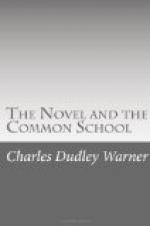hundred young men and women are diligently, day and
night, learning the rudiments of art. The result
is already apparent. Excellent drawing is seen
in illustrations for books and magazines, in the satirical
and comic publications, even in the advertisements
and theatrical posters. At our present rate of
progress, the drawings in all our amusing weeklies
will soon be as good as those in the ‘Fliegende
Blatter.’ The change is marvelous; and
the popular taste has so improved that it would not
be profitable to go back to the ill-drawn illustrations
of twenty years ago. But as to fiction, even
if the writers of it were all trained in it as an
art, it is not so easy to lift the public taste to
their artistic level. The best supply in this
case will only very slowly affect the quality of the
demand. When the poor novel sells vastly better
than the good novel, the poor will be produced to
supply the demand, the general taste will be still
further lowered, and the power of discrimination fade
out more and more. What is true of the novel
is true of all other literature. Taste for it
must be cultivated in childhood. The common schools
must do for literature what the art schools are doing
for art. Not every one can become an artist,
not every one can become a writer—though
this is contrary to general opinion; but knowledge
to distinguish good drawing from bad can be acquired
by most people, and there are probably few minds that
cannot, by right methods applied early, be led to prefer
good literature, and to have an enjoyment in it in
proportion to its sincerity, naturalness, verity,
and truth to life.
It is, perhaps, too much to say that all the American
novel needs for its development is an audience, but
it is safe to say that an audience would greatly assist
it. Evidence is on all sides of a fresh, new,
wonderful artistic development in America in drawing,
painting, sculpture, in instrumental music and singing,
and in literature. The promise of this is not
only in the climate, the free republican opportunity,
the mixed races blending the traditions and aptitudes
of so many civilizations, but it is in a certain temperament
which we already recognize as American. It is
an artistic tendency. This was first most noticeable
in American women, to whom the art of dress seemed
to come by nature, and the art of being agreeable
to be easily acquired.
Already writers have arisen who illustrate this artistic
tendency in novels, and especially in short stories.
They have not appeared to owe their origin to any
special literary centre; they have come forward in
the South, the West, the East. Their writings
have to a great degree (considering our pupilage to
the literature of Great Britain, which is prolonged
by the lack of an international copyright) the stamp
of originality, of naturalness, of sincerity, of an
attempt to give the facts of life with a sense of
their artistic value. Their affiliation is rather
with the new literatures of France, of Russia, of Spain,




